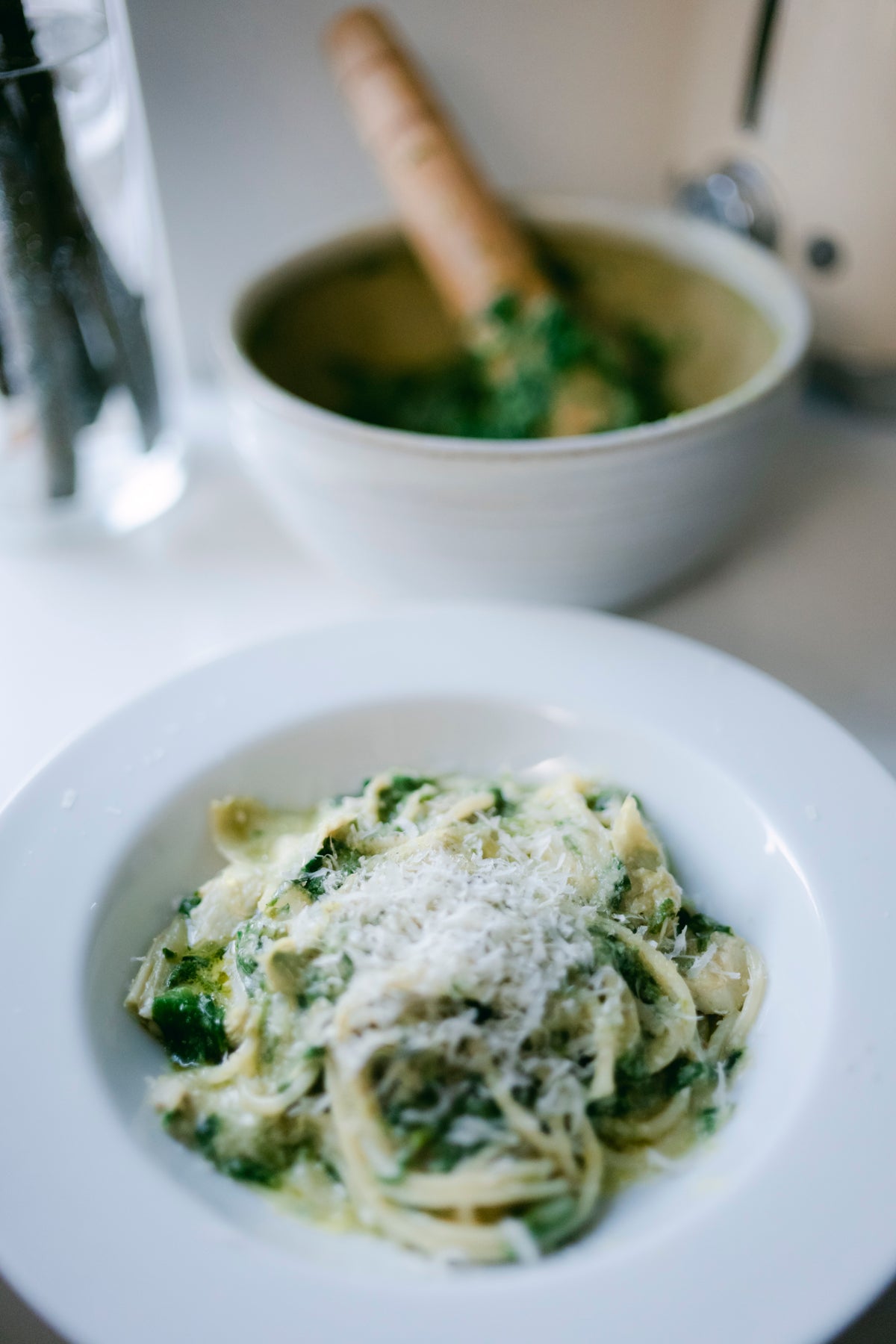
As the seasons change, we embrace the flavors that speak to the liminal moment—ramps, green garlic, rhubarb, asparagus... the harbingers of spring. This week, chef, food stylist, event producer and culinary entrepreneur, Jillian Canaj, shares a recipe highlighting one of the ephemeral ingredients of the moment.
Using Alice's Mortar & Pestle, Jillian makes an emerald green wild ramp sauce, proving that you can't beat a hand-pounded pesto. Don't have ramps where you live? Fear not, we've got you covered!
Jillian's Creamy Ramp Pesto Spaghetti with Baby Artichokes
All photos by Daniel Polizzano
Ramps! For their fleeting season, they are the highlight on restaurant menus across the country, where chefs distill them into oils, weave them into sourdough, and ferment the leaves to transform them into silky sauces. It’s easy to be allured by this wild-forged allium, but deciding what to do with them can be tricky—especially for a home cook.
This ramp pesto spaghetti has been a star in my home since the days when I’d sneak away from the desk at my corporate job to snag the last remaining bunches at the market. The recipe is simple enough that I could make it in about 30 minutes after a long commute. It’s delightfully creamy, punchy, and reminiscent of a classic spinach and artichoke dip—just what you want on a cool, spring evening.
A mortar and pestle is key to making this dish a knock-out. It begins with pounding garlic to a sticky paste that clings to soft, toasted pine nuts and releases an aroma that reminds me of the warm garlic knots from the local slice shops I grew up and regularly visited here in Brooklyn. I love the coarse ceramic groves in Alice’s Mortar and pestle, they do much of the grinding work for you easing the physical burden and speeding up the process of making this garlic pine nut paste. Usually, I encourage measuring garlic with your heart, but ramps have a strong garlic flavor, so be careful not to use too much.
Next, blanched ramp leaves are pounded into the pine nut and garlic paste, which releases their flavor, unlike any machine-made counterpart. To finish, olive oil is emulsified into the base through constant pounding and swirling of the pestle, and freshly grated cheese is folded in to yield a thick, creamy sauce.
I would typically poach baby artichokes fresh, but canned artichokes introduce acidity that is needed to balance this velvety pasta dish. The native forest organic brand is unmatched. They plump up beautifully in the warm pesto and absorb the flavor quickly. Use more pesto than you would think—at least 1/2 cup for two people.
If you have any leftover pesto, we love to fry eggs in it the following morning and serve it on toasted sourdough.
Creamy Ramp Pesto Spaghetti with Baby Artichokes
Ingredients
Serves 2
- 3 garlic cloves, germ removed
- 1/4 cup pine nuts
- About 25 ramp leaves, stems saved for pickling* (if you don't have access to ramps, use a combination of baby spinach leaves, fresh basil leaves and 4-6 cloves of peeled garlic)
- About 1/4 freshly grated Parmigiano Reggiano cheese, plus more for finishing
- Fleur de sel, to taste
- 1 can quartered artichoke hearts
- 4oz dry spaghetti
Ramp Pesto
- Pound garlic in mortar and pestle with a pinch of fleur de sel until the garlic is a sticky paste
- Gently toast pine nuts in a dry sauté pan until just golden. Pour pine nuts directly into your mortar and pestle and continue to pound to a smooth paste.
- Boil ramps in water for a couple of seconds, then immediately add to ice water to blanch them
- Squeeze out the excess water with your hands, then roughly chop the leaves
- Incorporate the chopped ramp leaves with the pine nut and garlic paste pounding and swirling around the sides to create a uniform paste
- Slowly stream in olive oil until you reach a saucey consistency
- Fold in freshly grated Parmigiano Reggiano cheese
- Adjust pesto with more olive oil, fleur de sel, or cheese to taste
- If you plan to save or gift pesto, jar and cover it with a thick layer of olive oil to keep it fresh. Basil pesto will keep in the fridge for 2 weeks or in the freezer for 6 months.
Creamy Ramp Pesto Spaghetti with Baby Artichokes
- Drop spaghetti in a pot of boiling salted water for 5 minutes
- Meanwhile, spoon ramp pesto into a sauté pan and simmer with a splash of pasta water
- Add drained artichoke hearts to the ramp pesto to warm and plump up with the flavors of the pesto
- Once the spaghetti is par-cooked, add straight to the sauce, toss, and emulsify with more pasta water until al dente and the sauce is rich and creamy
- Plate, and garlic with freshly-grated cheese and a drizzle of your favorite olive oil to finish
*To pickle ramp stems, boil equal parts raw cane sugar and vinegar until the sugar dissolves. Pour over cleaned ramp stems in a glass jar, seal, and keep in the fridge. I like to chop finely and add to salad dressing, aioli, and sandwiches









